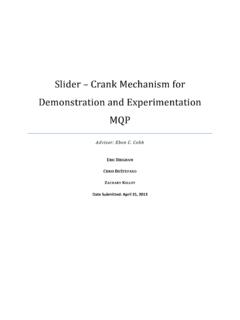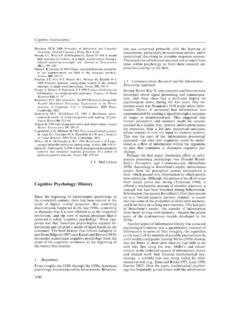Transcription of establishing a carbon border adjustment mechanism ...
1 EN EN EUROPEAN COMMISSION Brussels, COM(2021) 564 final 2021/0214 (COD) Proposal for a REGULATION OF THE EUROPEAN PARLIAMENT AND OF THE COUNCIL establishing a carbon border adjustment mechanism (Text with EEA relevance) {SWD(2021) 643 final} - {SWD(2021) 644 final} - {SWD(2021) 647 final} - {SEC(2021) 564 final} EN 0 EN EXPLANATORY MEMORANDUM 1. CONTEXT OF THE PROPOSAL Reasons for and objectives of the proposal The world is facing a profound climate crisis and the challenges of climate change require a global response. Strong international cooperation will strengthen the joint climate action needed by all the Parties of the Paris Agreement to meet the goal of holding the increase in the global average temperature to well below 2 C above pre-industrial levels and pursuing efforts to limit the temperature increase to C above pre-industrial levels1.
2 The European Union s international leadership must go hand in hand with bold domestic action. To meet the objective of a climate-neutral EU by 2050 in line with the Paris Agreement, the Union needs to increase its ambition for the coming decade and update its climate and energy policy framework. This process is already projected to start under the existing EU legislation. Furthermore, as announced in the European Green Deal2, the Commission has proposed a new EU target for 2030 of reducing greenhouse gas ( GHG ) emissions by at least 55 per cent compared to levels in 19903, based on a comprehensive impact assessment4. This objective has been endorsed by the European Council5 and communicated to the United Nations Framework Convention on Climate Change making it internationally binding6.
3 The European Climate Law, as agreed with the co-legislators, sets the new 2030 target while making the EU s climate neutrality objective legally binding7. To deliver on these GHG emissions reductions in line with the European Climate Law, the Commission proposes to revise where necessary all relevant policy instruments by July 2021 in a Fit for 55 Package , which covers in particular the review of sectoral legislation in the fields of climate, energy, transport, and taxation8. A carbon border adjustment mechanism ( CBAM ), announced in the European Green Deal, is part of that package and will serve as an essential element of the EU toolbox to meet the objective of a climate-neutral EU by 2050 in line with the Paris Agreement by addressing risks of carbon leakage as a result of the increased Union climate ambition.
4 The European Parliament adopted in March 2021 a resolution advocating for the introduction of a WTO-compatible carbon border adjustment mechanism9. 1 Article 2(1)(a) of the Paris Agreement. 2 Communication from the Commission of 11 December 2019 on The European Green Deal (COM(2019) 640 final, p. 4. 3 The Commission put forward the proposal COM(2020) 563 final, amending the initial Commission proposal on the European climate law to include a revised EU emission reduction target of at least 55 % by 2030. On 10-11 December 2020, the European Council in its conclusions endorsed this increased EU target. 4 Communication from the Commission of 17 September 2020 on Stepping up Europe s 2030 climate ambition.)
5 (COM(2020) 562 final: Part 1/2). 5 Conclusions of the European Council of 11 December 2020. (EUCO 22/20 CO EUR 17 CONCL 8). 6 German Presidency of the Council of the EU (2020). The update of the nationally determined contribution of the European Union and its Member States. 7 Regulation (EU) 2021/1119 of the European Parliament and of the Council of 30 June 2021 establishing the framework for achieving climate neutrality and amending Regulation (EU) 2018/1999 ( European Climate Law ) (OJ L 243, , p. 1). 8 Commission Work Programme 2021. (COM(2020) 690 final). Annex I outlines all the instruments under the package. 9 European Parliament resolution of 10 March 2021 Towards a WTO-compatible EU carbon border adjustment mechanism .
6 EN 1 EN The Commission also announced in its EU Action Plan: Towards Zero Pollution for Air, Water and Soil10 the promotion of relevant instruments and incentives to better implement the polluter pays principle11 and thus complete the phasing out of pollution for free with a view to maximising synergies between decarbonisation and the zero pollution ambition. The Commission announced its intention to propose a CBAM in the European Green Deal. As indicated in the Communication Should differences in levels of ambition worldwide persist, as the EU increases its climate ambition, the Commission will propose a carbon border adjustment mechanism , for selected sectors, to reduce the risk of carbon leakage.
7 This would ensure that the price of imports reflect more accurately their carbon content. This measure will be designed to comply with World Trade Organization rules and other international obligations of the EU12 . This mechanism is an alternative to the measures that address the risk of carbon leakage in the EU s Emissions Trading System13 ( EU ETS ) and is meant to avoid that the emissions reduction efforts of the Union are offset by increasing emissions outside the Union through relocation of production or increased imports of less carbon -intensive products. Without such a mechanism , carbon leakage could result in an overall increase in global emissions.
8 The Paris Agreement commits the international community to a continuous increase in the ambition of climate action to limit global average temperature rise in order to significantly reduce the risks and impacts of climate change. Each Party must prepare its own nationally determined contribution ( NDC ) towards this global goal, reflecting its highest possible ambition as well as its common but differentiated responsibilities and respective capabilities, in the light of different national circumstances14. As long as significant numbers of the EU s international partners have policy approaches that do not result in the same level of climate ambition as the Union, and differences in the price applied to GHG emissions remain, there is a risk of carbon leakage.
9 carbon leakage occurs if, for reasons of differing ambitions related to climate policies, businesses in certain industry sectors or subsectors were to transfer production to other countries with less stringent emission constraints or imports from these countries would replace equivalent but less GHG emissions intensive products due to the difference in climate policy. That would risk undermining the effectiveness of the EU s emission mitigation policies, and could also lead to an increase in their total emissions globally, thus jeopardising the reduction of GHG emissions that is urgently needed if the world is to keep the global average temperature to well below 2 C above pre-industrial levels.
10 Currently, the risk of carbon leakage is being addressed in the Union under the EU ETS. This is the world's first international GHG emissions trading system and has been in place since 2005. For the sectors covered by this system and most at risk of carbon leakage, this risk is currently managed through the granting of free allowances and compensations for the increase in electricity costs under state aid rules. However, free allocation under the EU ETS weakens the price signal that the system provides for the installations receiving it compared to full 10 Communication from the Commission of 12 May 2021 on Pathway to a Healthy Planet for All (COM(2021) 400 final).


















